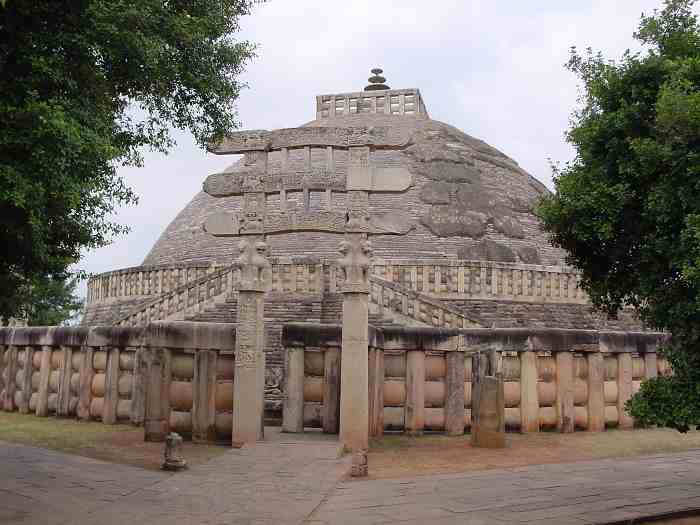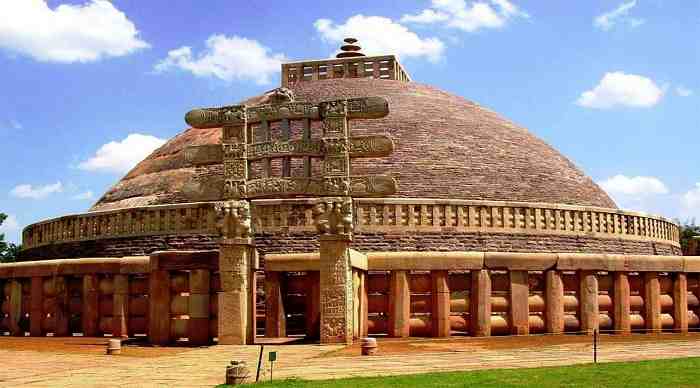When was it built: Commissioned in 3rd century BCE, Expansion/ additions/restoration works/ made in different periods
Who built it: Commissioned by Emperor Ashoka of the Maurya Dynasty
Where is it located: Located 46 km north-east of Bhopal, the capital city of Madhya Pradesh, India
Architectural Style: Buddhist Art and Architecture
Visit Timing: Sunrise to Sunset
How to Reach: By Air or rail to Bhopal which is well-connected with many other cities of India and then by road to Sanchi by bus, cabs and private cars provided by different tour operators. Sanchi can also be reached by road from Vidisha (10 km) and Indore (232 km).

The Great Stupa at Sanchi is one of the most important Buddhist monuments reflecting gem of Buddhist art and architecture. Located at Sanchi Town, Madhya Pradesh, India, this Stupa is the oldest stone structure in India that was built during the Mauryan period. Originally commissioned in the third century BCE by Emperor Ashok this huge hemispherical dome with a height of 12.2816.46 m (54.0 ft) consists of a central chamber where the relics of Lord Buddha are placed. Four ornamental gateways facing four directions and a balustrade surrounding the Stupa were later added in the first century BCE. A typical example of a Stupa and an excellent illustration of the development of Buddhist art and sculpture starting from the third century BC through the twelfth century AD, the Sanchi Stupa attracts hundreds of visitors from across the world. Enlisted as a UNESCO World Heritage Site since 1989, it is counted among the best conserved ancient Stupas of central India.
Foundation of the Stupa
The foundation of the Buddhist vihara at Sanchi that includes the great Sanchi Stupa was laid by one of the greatest Indian Emperors, Ashoka of the Maurya Dynasty who reigned over almost the entire Indian subcontinent from c. 268 to 232 BCE. He commissioned construction of the Stupa here after redistributing the mortal remains of Lord Buddha so as to build several Stupas in different locations across India to spread Buddhism. The present hemispherical edifice is double in diameter of the original brick structure built by Ashoka, consisting of the relics of Lord Buddha. A chatra that is an umbrella like structure made of stone crowned the hemispherical brick structure that was surrounded by a wooden railing. Queen Devi, wife of Ashoka and daughter of a merchant of Vidisha, who was born in Sanchi, supervised the construction of this monument. A sandstone pillar, inscribed with Schism Edict by Ashoka as also with ornate spiral Brahmi characters from the Gupta period resembling conch shells referred as ‘Shankhalipi’ or ‘shell-script’ by scholars, was erected in the site. While the lower portion of it is still grounded, the upper portions are kept under a canopy.

Probable Destruction and Expansion of the Stupa during Shunga Period
The Senapati or General of the Maurya Empire, Pushyamitra Shunga killed Brihadratha Maurya, the last Mauryan Emperor in the middle of an army review in 185 BCE and laid the foundation of the Shunga Empire in North India. Going by the Indian Sanskrit-language text titled ‘Ashokavadana’ that describes the birth and reign of Ashoka, assumptions crop up that the Stupa was probably destroyed during the second century BCE, an incident which many believe to be associated with the rise of the power of Pushyamitra. Later it was re-constructed by his son, Agnimitra.
During the Shunga dynasty, expansion of the Stupa, nearly double its original size with a more flattened dome was undertaken using stone slabs that entirely covered the actual brick Stupa. Three superimposed umbrella-like structures were built to crown the dome. It symbolised the Wheel of Law or ‘dharma’. A high rounded drum that can be reached through a double staircase became the seat of the dome enabling one to circumambulate the sacred dome.

Construction & Decoration of the Gateways
As perceived from inscriptions, presumably the four intricately decorated torans or gateways facing all four directions and an ornamented balustrade surrounding the stupa were added later in the first century BCE during the Satavahana rule. Various designs and motifs are carved on the railing and the gates of the Stupa. The sculptures on the torans consist of decorative illustrations of events encompassing the life of Lord Buddha as elucidated in the tales of Jataka. Inanimate figures like that of a tree are used here to symbolise Lord Buddha. One of the most striking features regarding the Stupa is that instead of images, Lord Buddha has been depicted symbolically by figures like thrones, wheels and footprints among others.

Image Credit: historyinindia.com
Re-discovery in the 19th Century & Restoration Works
In 1818, the existence of the Sanchi Stupa was documented in English by a British officer named General Taylor. Till 1881 treasure hunters and Amateur archaeologists caused extensive damage to the Stupa following which appropriate steps were undertaken to restore the ancient monument. Sir John Hubert Marshall, who served as the Director General of the ‘Archaeological Survey of India’ (ASI) from 1902 to 1928 supervised the restoration work of the Stupa between 1912 and 1919.
A visit to the Great Stupa at Sanchi
This fascinating and world famous Stupa and other structures in Sanchi portraying brilliance of Buddhist art and sculpture attract attention of thousands of visitors round the year including national and foreign tourists, archaeologists and historians among others. The site remains open from sunrise to sunset. As climate of the place remains hot throughout the year, the best time to visit Sanchi is during the winters, from November to March. Entry fees per person for Indian citizens and visitors of SAARC and BIMSTEC nations is Rs. 30/- and for others is Rs. 500/-. Entry is free for children up to 15 years of age.

Image Credit: thehistoryhub.com



